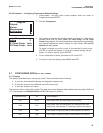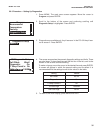
39
MODEL FCL-1056 SECTION 6.0
CALIBRATION
6.3 CALIBRATION — FREE CHLORINE
6.3.1 Purpose
As Figure 6-1 shows, a free chlorine sensor generates
a current directly proportional to the concentration of
free chlorine in the sample. Calibrating the sensor
requires exposing it to a solution containing no chlorine
(zero standard) and to a solution containing a known
amount of chlorine (full-scale standard).
The zero standard is necessary because chlorine sen-
sors, even when no chlorine is in the sample, generate
a small current called the residual current or zero cur-
rent. The analyzer compensates for the residual current
by subtracting it from the measured current before con-
verting the result to a chlorine value. New sensors
require zeroing before being placed in service, and
sensors should be zeroed whenever the electrolyte
solution is replaced. Either of the following makes a
good zero standard:
• Deionized water containing about 500 ppm sodium chloride. Dissolve about 0.5 grams (1/8 teaspoonful) of
table salt in 1 liter of water. DO NOT USE DEIONIZED WATER ALONE FOR ZEROING THE SENSOR. THE
CONDUCTIVITY OF THE ZERO WATER MUST BE GREATER THAN 50 uS/cm.
• Tap water known to contain no chlorine. Expose tap water to bright sunlight for at least 24 hours.
The purpose of the full-scale standard is to establish the slope of the calibration curve. Because stable chlorine
standards do not exist, the sensor must be calibrated against a test run on a grab sample of the process
liquid. Several manufacturers offer portable test kits for this purpose. Observe the following precautions when
taking and testing the grab sample.
• Take the grab sample from a point as close to the FCL as possible. Be sure that taking the sample does not
alter the flow of the sample to the unit. It is best to install the sample tap just downstream from the tap for
the FCL.
• Chlorine solutions are unstable. Run the test immediately after taking the sample. Try to calibrate the
sensor when the chlorine concentration is at the upper end of the normal operating range.
Free chlorine measurements also require a pH correction. Free chlorine is the sum of hypochlorous acid (HOCl)
and hypochlorite ion (OCl
-
). The relative amount of each depends on pH. As pH increases, the concentration of
HOCl decreases and concentration of OCl
-
increases. Because the sensor responds only to HOCl, a pH correc-
tion is necessary to properly convert the sensor current into a free chlorine reading.
The analyzer uses either continuous (live) or manual pH correction. In continuous (live) correction the analyzer
continuously monitors the pH of the sample and corrects the free chlorine reading for changes in pH. In manual
pH correction, the analyzer uses the pH entered by the user for the pH correction. Generally, if the pH changes
more than about 0.2 units over short periods of time, continuous (live) pH correction is recommended. If the pH is
relatively steady or subject only to seasonal changes, manual pH correction is adequate.
During calibration, the analyzer must know the pH of the solution. If the analyzer is using automatic pH correction,
the pH sensor (properly calibrated) must be in the process liquid before starting the calibration. If the analyzer is
using manual pH correction, be sure to enter the pH value before starting the calibration.
6.3.2 Procedure-Zeroing the Sensor
1. Place the sensor in the zero standard. See Section 6.3.1 for suggested zero standards. Be sure no air bubbles
are trapped against the membrane. The sensor current will drop rapidly at first and then gradually reach a stable
zero value. To monitor the sensor current, press the DIAG key. Choose Sensor 1 (chlorine). The input current
is the first line in the display. Note the units: nA is nanoamps, uA is microamps. Typical zero current for a
new sensor is between -10 and 10 nA.
A new sensor or a sensor in which the electrolyte solution has been replaced may require several hours (occa-
sionally as long as overnight) to reach a minimum zero current. DO NOT START THE ZERO ROUTINE UNTIL
THE SENSOR HAS BEEN IN THE ZERO SOLUTION FOR AT LEAST TWO HOURS.
2. Press MENU. The main menu screen appears. The cursor will be on Calibrate. Press ENTER.
FIGURE 6-1. Sensor Current as a Function of
Free Chlorine Concentration


















